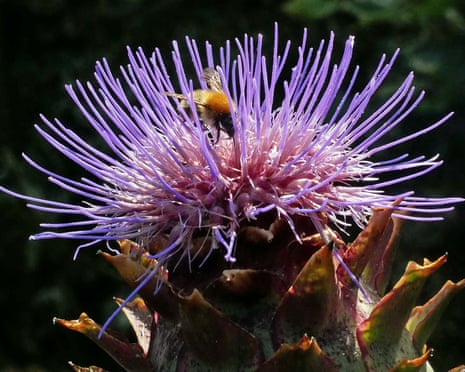Top Stories
Garden Ecosystem Thrives Amid Insect Activity in Early Summer

A vibrant ecosystem is taking shape in a backyard garden, driven by the activity surrounding a single cardoon plant. Observers noted a significant increase in biodiversity as various insect species interacted with the plant, particularly in the early summer months of June and July 2023.
The initial observation began in early June when small clusters of black aphids appeared on the cardoon. Ants, drawn to the aphids, were seen climbing the plant’s stems, tending to the colonies by stroking them with their antennae and legs. This symbiotic relationship, known as aphid “farming,” has been documented for centuries. Notably, Sir John Lubbock, a prominent figure in entomology and a friend of Charles Darwin, detailed similar behaviors in his 1882 work, *Ants, Bees and Wasps*.
As summer progressed, the aphid population exploded, leading to a noticeable decline in the plant’s vitality. By early July, new colonies had formed, causing the cardoon’s flower stems to bow under the weight of countless sap-sucking insects. The phenomenon culminated in what is referred to as “flying ant day,” during which the ant population diminished, but the aphids continued to thrive.
With the aphid colonies unchecked, a new wave of insect activity emerged. Hoverflies arrived in droves to consume the sweet honeydew secreted by the aphids, while simultaneously laying their eggs among them. As the predatory larvae hatched, they began to decimate the aphid population. The garden transformed into a dynamic battleground, a scene reminiscent of a post-apocalyptic landscape, littered with the remnants of the aphid colonies.
The aftermath has seen a resurgence of various insect species. Seven-spot, 14-spot, and harlequin ladybirds have begun to roam the leaves, preying on any remaining aphids. Meanwhile, other opportunistic insects like neon purple jewel wasps and hyperactive ichneumon wasps have also made their presence known. The garden now buzzes with life, showcasing the intricate web of connections that exists within a seemingly simple ecosystem.
In the wake of this natural drama, the cardoon plant shows signs of recovery. Some wilted flower buds are reviving, and a few, though smaller than usual, have opened to display their striking blue florets, which attract bumblebees.
This unfolding cycle of life highlights the delicate balance within ecosystems and the profound impact of human intervention. A single application of insecticide just six weeks prior could have dramatically altered this vibrant narrative, preventing the diverse interactions that have taken place.
The observations made by Phil Gates serve as a reminder of the intricate relationships between species and the importance of maintaining biodiversity in our gardens. As life continues to flourish in this small patch of nature, it emphasizes the interconnectedness of all living things and the vital role each plays in sustaining our environment.
-

 Entertainment2 months ago
Entertainment2 months agoIconic 90s TV Show House Hits Market for £1.1 Million
-

 Lifestyle4 months ago
Lifestyle4 months agoMilk Bank Urges Mothers to Donate for Premature Babies’ Health
-

 Sports3 months ago
Sports3 months agoAlessia Russo Signs Long-Term Deal with Arsenal Ahead of WSL Season
-

 Lifestyle4 months ago
Lifestyle4 months agoShoppers Flock to Discounted Neck Pillow on Amazon for Travel Comfort
-

 Politics4 months ago
Politics4 months agoMuseums Body Critiques EHRC Proposals on Gender Facilities
-

 Business4 months ago
Business4 months agoTrump Visits Europe: Business, Politics, or Leisure?
-

 Lifestyle4 months ago
Lifestyle4 months agoJapanese Teen Sorato Shimizu Breaks U18 100m Record in 10 Seconds
-

 Politics4 months ago
Politics4 months agoCouple Shares Inspiring Love Story Defying Height Stereotypes
-

 World4 months ago
World4 months agoAnglian Water Raises Concerns Over Proposed AI Data Centre
-

 Sports4 months ago
Sports4 months agoBournemouth Dominates Everton with 3-0 Victory in Premier League Summer Series
-

 World4 months ago
World4 months agoWreckage of Missing Russian Passenger Plane Discovered in Flames
-

 Lifestyle4 months ago
Lifestyle4 months agoShoppers Rave About Roman’s £42 Midi Dress, Calling It ‘Elegant’









